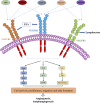Recent advances of anti-angiogenic inhibitors targeting VEGF/VEGFR axis
- PMID: 38239196
- PMCID: PMC10794590
- DOI: 10.3389/fphar.2023.1307860
Recent advances of anti-angiogenic inhibitors targeting VEGF/VEGFR axis
Abstract
Vascular endothelial growth factors (VEGF), Vascular endothelial growth factor receptors (VEGFR) and their downstream signaling pathways are promising targets in anti-angiogenic therapy. They constitute a crucial system to regulate physiological and pathological angiogenesis. In the last 20 years, many anti-angiogenic drugs have been developed based on VEGF/VEGFR system to treat diverse cancers and retinopathies, and new drugs with improved properties continue to emerge at a fast rate. They consist of different molecular structures and characteristics, which enable them to inhibit the interaction of VEGF/VEGFR, to inhibit the activity of VEGFR tyrosine kinase (TK), or to inhibit VEGFR downstream signaling. In this paper, we reviewed the development of marketed anti-angiogenic drugs involved in the VEGF/VEGFR axis, as well as some important drug candidates in clinical trials. We discuss their mode of action, their clinical benefits, and the current challenges that will need to be addressed by the next-generation of anti-angiogenic drugs. We focus on the molecular structures and characteristics of each drug, including those approved only in China.
Keywords: VEGF; VEGFR; angiogenesis; anti-angiogenic; inhibitors.
Copyright © 2024 Wang, Liu, Broussy, Han and Fang.
Conflict of interest statement
The authors declare that the research was conducted in the absence of any commercial or financial relationships that could be construed as a potential conflict of interest.
Figures



Similar articles
-
Vascular endothelial growth factor (VEGF) - key factor in normal and pathological angiogenesis.Rom J Morphol Embryol. 2018;59(2):455-467. Rom J Morphol Embryol. 2018. PMID: 30173249 Review.
-
Vascular Endothelial Growth Factor (VEGF) and Its Receptor (VEGFR) Signaling in Angiogenesis: A Crucial Target for Anti- and Pro-Angiogenic Therapies.Genes Cancer. 2011 Dec;2(12):1097-105. doi: 10.1177/1947601911423031. Genes Cancer. 2011. PMID: 22866201 Free PMC article.
-
Development of vascular endothelial growth factor receptor (VEGFR) kinase inhibitors as anti-angiogenic agents in cancer therapy.Curr Med Chem. 2004 Mar;11(6):731-45. doi: 10.2174/0929867043455756. Curr Med Chem. 2004. PMID: 15032727 Review.
-
Anti-angiogenic Agents: A Review on Vascular Endothelial Growth Factor Receptor-2 (VEGFR-2) Inhibitors.Curr Med Chem. 2021;28(13):2540-2564. doi: 10.2174/0929867327666200514082425. Curr Med Chem. 2021. PMID: 32407259 Review.
-
The vascular endothelial growth factors and receptors family: Up to now the only target for anti-angiogenesis therapy.Int J Biochem Cell Biol. 2015 Jul;64:185-9. doi: 10.1016/j.biocel.2015.04.008. Epub 2015 May 1. Int J Biochem Cell Biol. 2015. PMID: 25936669
Cited by
-
VEGF-Virus Interactions: Pathogenic Mechanisms and Therapeutic Applications.Cells. 2024 Nov 4;13(21):1815. doi: 10.3390/cells13211815. Cells. 2024. PMID: 39513922 Free PMC article. Review.
-
Identification of a Natural Small Molecule Dauricine for Glioma Therapy through Targeting p53 and VEGFA Pathways.ACS Omega. 2025 Jun 3;10(23):24587-24600. doi: 10.1021/acsomega.5c01334. eCollection 2025 Jun 17. ACS Omega. 2025. PMID: 40547611 Free PMC article.
-
Vascular Endothelial Growth Factor (VEGF) and VEGF Receptor Inhibitors in Health and Disease.Pharmaceuticals (Basel). 2024 Jul 18;17(7):959. doi: 10.3390/ph17070959. Pharmaceuticals (Basel). 2024. PMID: 39065805 Free PMC article.
-
Increase in Vascular Endothelial Growth Factor (VEGF) Expression and the Pathogenesis of iMCD-TAFRO.Biomedicines. 2024 Jun 14;12(6):1328. doi: 10.3390/biomedicines12061328. Biomedicines. 2024. PMID: 38927535 Free PMC article. Review.
-
Discovery of Novel Multiangiogenic Agents Targeting VEGFR2, EphB4, FGFR-1, and TIE-2: Receptor-Based Pharmacophore Modeling, Virtual Screening, and Molecular Modeling Studies.ACS Omega. 2025 Apr 1;10(14):13880-13897. doi: 10.1021/acsomega.4c08366. eCollection 2025 Apr 15. ACS Omega. 2025. PMID: 40256504 Free PMC article.
References
-
- Aghajanian C., Bell-Mcguinn K. M., Burris H. A., 3rd, Siu L. L., Stayner L. A., Wheler J. J., et al. (2018). A phase I, open-label, two-stage study to investigate the safety, tolerability, pharmacokinetics, and pharmacodynamics of the oral AKT inhibitor GSK2141795 in patients with solid tumors. Invest. New Drugs 36, 1016–1025. 10.1007/s10637-018-0591-z - DOI - PMC - PubMed
Publication types
LinkOut - more resources
Full Text Sources

